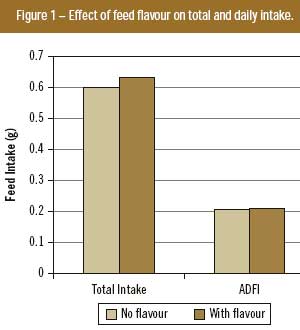Influence of feed flavour on pre-weaning pig performance

A flavour is the sensory impression of a food or other substance, and is determined mainly by the senses of taste and smell. Feed flavours are commonly used in swine nursery diets to improve diet palatability and stimulate intake. However, evidence of the potential effects of adding flavours to creep feed on pre-weaning feed intake and performance is quite limited.
Historically, early research examining creep feeding used feed disappearance for the entire litter to determine if the creep feed was being consumed. This could be misleading as it assumes that all piglets in a litter consumed the creep feed. Recent creep feed studies, using colour markers in the feed, have shown that only a certain proportion of piglets actually consume creep feed. These “eaters” as a result have better initial post weaning feed intake and growth performance than those in the litter that do not consume creep feed.Subsequently, researchers have tried to identify factors that increase the proportion of eaters within a litter to improve overall nursery performance. One key dietary factor may be how the creep feed smells. It is also thought that exposure to the flavour in the pre-weaning period may also improve post-weaning performance when the same flavour is added to the nursery diets.
Adding flavour
In a recent study, researchers at Kansas State University examined the role of using a feed flavour to increase pre-weaning and post-weaning performance. In the first part of the experiment the researchers used two experimental diets; a creep diet with no flavour added and a creep diet with a flavour added. Both diets were offered free choice from day 18 of lactation to weaning at day 21. In addition, both creep diets contained a colour marker which was used to evaluate whether piglets were eaters or non-eaters. All sows were fed the same lactation diet, and water was offered free choice to both sows and piglets.The results of this study found that overall litter weaning weight, total body weight gain and average daily gain (ADG) between litters fed creep with or without flavour were not different. On an individual basis, piglet weaning weight, total body weight gain and ADG between the two diet treatments also was not different. The addition of a feed flavour to the creep feed did not influence total or daily creep feed intake (ADFI) or the proportion of creep feed eaters in whole litters (Figures 1 and 2).
Poor response to flavour
The lack of response to the feed flavour may be due to the limited time of creep feeding. In this study the researchers chose a period of three days to reflect the current practise of US pig producers to provide creep feed for two to seven days before weaning. They felt that for the addition of flavour to be warranted that any effect must be visible in a short duration.
In their previous studies, researchers at Kansas State University found that 75% of the total litter creep feed intake was consumed in the last seven days before weaning. They also found that piglets given access to creep feed for two days before weaning consumed the same or greater amounts of creep feed compared with litters that were creep fed for seven to eleven days. These observations seem to indicate that creep feed intake is related to maturity of piglets rather than the duration of creep feeding. However, before producers start reducing the length of creep feeding, previous research at Kansas State University found that creep feeding duration does influence the proportion of eaters in whole litters. In their study, litters provided with creep feed for 13 days produced approximately 14% more eaters than litters fed creep for six days or two days (80%, 70% and 71% respectively). However, for a litter of 10 pigs a 14% increase in eaters translates to only one additional eater per litter.
Importance of creep feed
In summary, based on this study, providing a feed flavour in creep feed does little to increase pre-weaning performance or the number of eaters within a litter. This research highlights that creep feed is an important tool in transitioning piglets to solid feed. Piglets that are eaters of creep have improved feed intake and growth performance in the post weaning period and the longer the duration of creep feeding the higher number of eaters within a litter. However, the economic cost/benefit of the additional feed and labour required should be balanced against the potential increase in nursery performance.
Join 26,000+ subscribers
Subscribe to our newsletter to stay updated about all the need-to-know content in the feed sector, three times a week. Beheer
Beheer









 WP Admin
WP Admin  Bewerk bericht
Bewerk bericht